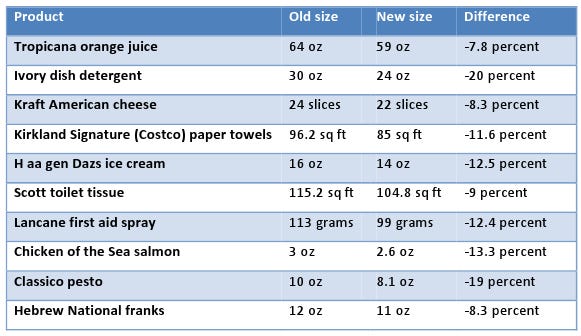March 11, 2015
Does it seem like some products don't last as long as they used to? From toothpaste to tuna fish, hot dogs to hand soap, companies have been shaving ounces and inches from packages for years. Consumer Reports' latest investigation, featured in the February 2011 issue of Consumer Reports and online at www.ConsumerReports.org, found that more and more products are getting downsized.
Household names like Tropicana orange juice, Ivory soap and Kraft singles American cheese are all playing the shrinking package game, and manufacturers are attributing it to rising costs for ingredients and energy. "They've got a point. Higher commodity and fuel costs are expected to spike in food prices by as much as 3 percent is 2011," says Tod Marks, senior editor and resident shopping expert at Consumer Reports. "But if manufacturers are skimping when costs go up, why aren't they more generous when costs hold steady or fall?"
Companies often hide their handiwork when they shrink their packages. Indenting the bottom of containers, making plastic wraps thinner or whipping air into ice cream are a few subtle ways companies downsize their products.
Reasons for reduction
Manufactures make subtle changes to the packages but generally keep the price the same because when prices rise, buyers often seek cheaper alternatives. And the bottom line is that consumers are more attuned to changes in price than packaging.
Consumer Reports found packages reduced in size by as much as 20 percent in its study. For example, Ivory dish detergent shrank from its 30-oz bottle to a new 24-oz bottle due to increased costs for raw materials, according to a customer service representative. And Haagen Dazs ice cream's 16-oz container shrank to a 14-oz container due to the cost of ingredients and facility costs. It was either change the size of the container or raise the price, according to customer service.
Here is a complete rundown of Consumer Reports findings:
Consumer Reports exposes shrinking packages
What shoppers can do
Despite awareness of downsizing, it's not easy to figure out which products have shrunk because relatively few package goods come in standard, recognizable sizes anymore. Other products come in such a range of sizes it's hard to tell when one of them shrinks. For example, Oreos come in more than a dozen packages weighing from 2 oz to more than 50 oz.
Consumer Reports offers these tips to help consumers shop the aisles with ease:
• Look at different brands. Not all manufacturers downsize. Minute Maid still sells its orange juice in half-gallons and Ben & Jerry's packs its ice cream in pints.
• Compare unit price. Look at cost per ounce, per quart, per pound, per sheet. Promotions change, making one size or another cheaper from week to week.
• Try store brands. House brands are usually 25 to 30 percent cheaper than name brands and are often at least as good.
• Stock up and save. Supermarkets sell staples such as paper goods, cereal and soups at or below cost and rotate them regularly. Many items go on sale at predictable intervals, so stock up until the next sale.
• Buy in bulk. Warehouse clubs offer everyday low prices on large sizes or multipacks.
• Contact the company. When Consumer Reports asked customer-service representatives why a product had been downsized, they often offered coupons as an apology.
If enough people complain about downsizing, companies may actually listen. When customers complained to Pepperidge Farm about a new smaller-sized, more-expensive wheat bread package, the company bought back the larger loaf briefly. It has since been discontinued.
Source: Consumer Reports
About the Author(s)
You May Also Like



